 |
| Best Diet for Health |
What is good health?
The word health is described as a state of complete physical and emotional well-being. To assist people, healthcare exists to maintain this optimal state of health.
Good health is handling stress and living an active and longer life. Health is a concept that focuses on social and personal resources, as well as physical capacities.
A healthy lifestyle motivates one to lead a full life with a specific purpose in life.
What to eat for overall health?
1) Whole-food diet, Low-carb
The whole-food diet, a low-carb diet, is excellent for people looking forward to losing weight, improving health, and reducing the risk of diseases.
This diet is available in fruits, vegetables, fish, meat but low in sugar, starches, and processed foods.
2) Mediterranean diet
It is considered to be an excellent diet. It’s particularly effective for preventing heart disease.
This type of diet involves plenty of fruits, whole grains, legumes, dairy products, extra virgin oil.
3) Paleo diet
This diet is a very famous diet that is very effective for weight loss and normal health improvement. If we talk about the present scenario then this diet is the world’s most famous diet.
4) Vegan diet
In the past decade, a vegan diet has become increasingly popular. It leads to many health benefits, including weight loss, improved cardiovascular health, and blood sugar control.
5)Gluten-free diet
The gluten-free diet is necessary for gluten intolerant people, a protein that is present in wheat and barley.
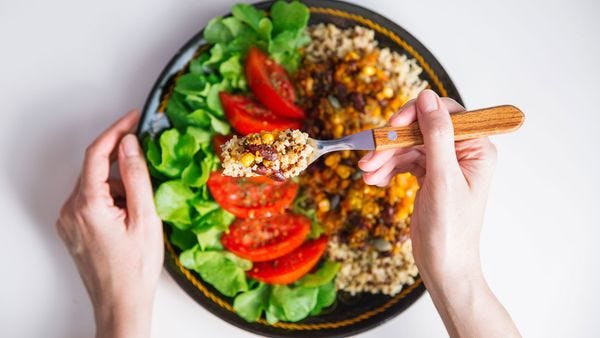
Best weight loss diet
Fruits are nature's ready-made snacks full of vitamins, fiber, and other essential nutrients that support a healthy diet.
Fruits have fewer calories and high fiber, which can assist in weight loss.
In fact, eating fruits is connected to a lower risk of diabetes, hypertension, cancer, and heart disease.
1) Grapefruit
It looks like an orange, and it is widely associated with dieting and weight loss plans.
Grapefruit has a low glycemic index, which shows that it releases sugar into your blood very slowly. A low GI may help in weight loss and weight maintenance.
Grapefruit can be eaten; likewise, it also makes an addition to salads and various other dishes.
2) Apples
Apples have low calories and are rich in fiber. Apples have been known to support weight loss.
Low-calories fruits give you a more filling feeling, which means you may eat fewer other foods during the entire day.
3)Berries
Berries are also low-calorie nutrient fruit. Additionally, berries can help in lowering cholesterol levels, blood pressure, and lower inflammation.
4)Stone fruits
Stone fruits, known as drupes, are seasonal fruits with a fleshy exterior and a stone inside. These involve plums, cherries, and apricots.
These fruits are low in GI and rich in nutrients like vitamin A and C, which help lose weight.
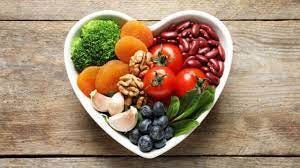
What is the best heart-healthy diet?
1) Control your portion size
The amount you eat is similarly just about as important as what you eat. Overloading your plate, taking seconds, and eating until you feel stuffed can prompt eating a more significant number of calories than you should.
Following a couple of tips to control food portion size can assist you with shape up your diet as well as your heart:
- Utilize a small plate or bowl to assist control your portions.
- Eat more low-calorie, nutrient-rich food, like fruits and vegetables.
- Eat less of unhealthy, high-sodium food varieties, like refined, processed or fast food.
- Monitor the number of servings you eat.
2) Eat more vegetables and fruits
Vegetables and organic products are excellent sources of nutrients and minerals. Vegetables and organic products are additionally low in calories and rich in dietary fiber. Vegetables and fruits contain substances that might assist in preventing cardiovascular disease. Eating more fruits might assist you to cut back on fatty food varieties, like meat, cheese, and snack foods.
3) Cutoff unhealthy fats
Restricting unhealthy fats in the diet brings you a step closer to lower your blood cholesterol and lower your danger of coronary artery disease. A high blood cholesterol level can prompt the development of plaques in your arteries, called atherosclerosis, which can raise your risk of respiratory failure and stroke.
4) Include whole grains
Whole grains are an excellent source of fiber and other various essential nutrients that plays a crucial role in regulating blood and heart health. You may raise the number of whole grains in a heart-healthy diet by looking for alternatives for refined grain products.
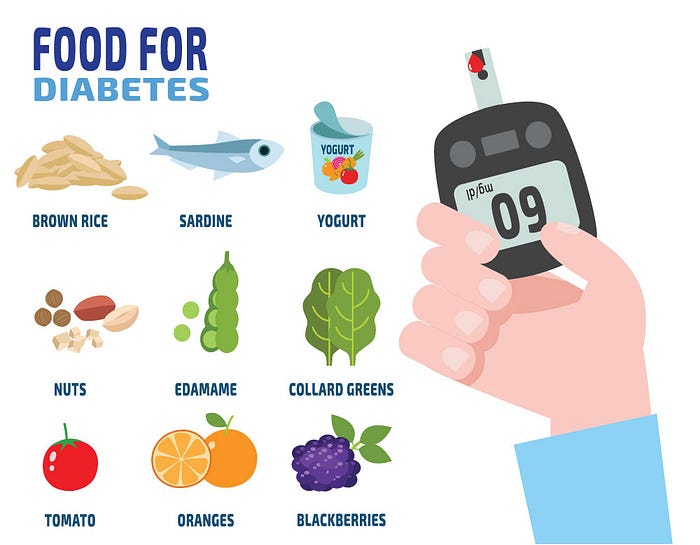
What are the foods I can eat if I have diabetes?
You might worry that having diabetes implies abandoning food that you enjoy. Fortunately, you can, in any case, eat your favourite foods, however, you may have to eat smaller portions or enjoy them less often. Your health care team will assist with making a diabetes meal plan for you that addresses your needs and likes.
A person suffering from diabetes has to eat a variety of quality food from all food groups, in the amount your meal plan shows.
The food groups are as follows:
-vegetables
- nonstarchy: involves broccoli, carrots, greens, peppers, and tomatoes
- starchy: incorporates potatoes, corn, and green peas
Grains — at least half of your grains ought to be whole grains
- includes rice, oats, wheat, grain, and quinoa
- example: bread, pasta, cereal, and tortillas
-fruits — involves oranges, melon, berries, apples, bananas, and grapes
-protein
- Meat(lean)
- Skinless chicken
- fish
- nuts and peanuts
- eggs
- meat substitutes, like tofu
- certain peas, like chickpeas
-dairy — nonfat or low fat
- milk or without lactose milk if you have lactose intolerance
- yoghurt
- cheese
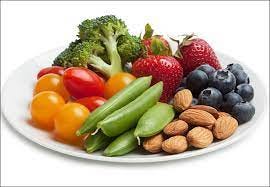
What should a CKD patient eat?
Chronic kidney disease is basically a mismatch of kidney function that is characterized by gradual loss of kidneys over a period of time. This disease takes several months and sometimes years to bring some noticeable signs and symptoms.
Chronic kidney disease can’t be treated but different modern treatment methods like dialysis or kidney transplant can increase the span of life for a certain period of time.
Diet restrictions depend on the level of kidney damage and it varies accordingly.
For example, people in the initial stages of kidney disorder have certain restrictions than those with kidney failure, which is also known as an end-stage renal disease (ESRD).
If you have a kidney disorder, your health care provider will tell you the best diet for your requirement.
For people suffering from advanced kidney disease, it’s crucial to follow a kidney-friendly diet that assists to decrease the number of toxins in the blood.
This diet is often called a renal diet.
It helps boost kidney working and preventing further damage
Various food that a kidney patient can eat are:
1) Cauliflower
Cauliflower is known as a nutritious vegetable that’s an excellent source of numerous nutrients, including vitamin C, vitamin K.
It also contains anti-inflammatory compounds like indoles and it is a good source of fiber.
2) Blueberries
Blueberries are full of nutrients and one of the greatest sources of antioxidants that you can eat.
These sweet berries have antioxidants called anthocyanins, which can protect against cardiovascular disease, certain cancers, and diabetes.
They also make an addition to a kidney-friendly diet, as they are low in sodium, phosphorus, and potassium.
3)Sea baas
Sea baas is a high-quality protein that has healthy fats called omega-3s.
Omega-3s help reduce inflammation and also help to decrease the risk of depression, and anxiety.
Mostly, all fish are high in phosphorus, sea bass contains fewer amounts than any other seafood.
4)Egg whites
Egg yolks have various healthy nutrients like sodium, protein, etc, they have large amounts of phosphorus, making egg whites a better option for people following a renal diet.
Egg whites give high quality, kidney-friendly source of protein.
Also, they’re a good choice for those who are on dialysis treatment, who have higher protein needs but need to limit phosphorus.
5) Garlic
People with kidney issues are recommended to limit the amount of sodium in their diet, including salt.
Garlic acts as an alternative to salt, adding flavour to dishes and providing nutritional benefits.
Garlic is a good source of manganese, vitamin C, and vitamin B6 and has sulfur compounds that have anti-inflammatory properties.
6)Olive oil
Olive oil contains healthy fat, which makes it a great option for people with kidney disease.
The maximum fat in olive oil is a monounsaturated fat called oleic acid, which has anti-inflammatory properties.
7)Skinless Chicken
Limited protein intake is necessary for some people with kidney issues, so it is necessary to provide the body with the right amount of high-quality protein for health.
Skinless chicken breast contains less amount of phosphorus, potassium, and sodium than the chicken that has skin.
Always opt for fresh chicken and avoid pre-made roasted chicken, as it has large amounts of sodium and phosphorus.
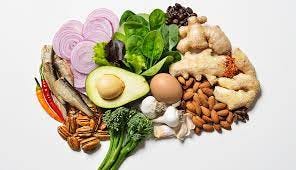
What to eat for a healthy brain?
It is always said that you reflect what you eat. An individual’s nutritional choices play a vital role in your overall health. There are certain foods that maintain the health of your brain. Eating the right food helps to keep the brain healthy and decreases the risk of developing neurological problems.
Below are the various foods that are healthy for the brain:
- Fatty fish
- Eggs
- Blueberries
- Nuts
- Fruits
- Seeds
- Turmeric
- Whole grains
Conclusion
A healthy diet is an essential part of living life and staying away from the disease.
A healthy diet can help you in many ways like weight loss, healthy brain, fit to healthy heart much more as I describe above. We are the Ayurveda experts. We provide treatment to those who are suffering from kidney disease in our life. We treat the patients through Ayurveda medicine for CKD chronic kidney disease. If you are suffering then contact us now or live your life free.
Disclaimer
The information shared in this content might vary from person to person and it is recommended to take proper advice from the doctor before opting for any diet.
Source of Content: Best Diet for Health








